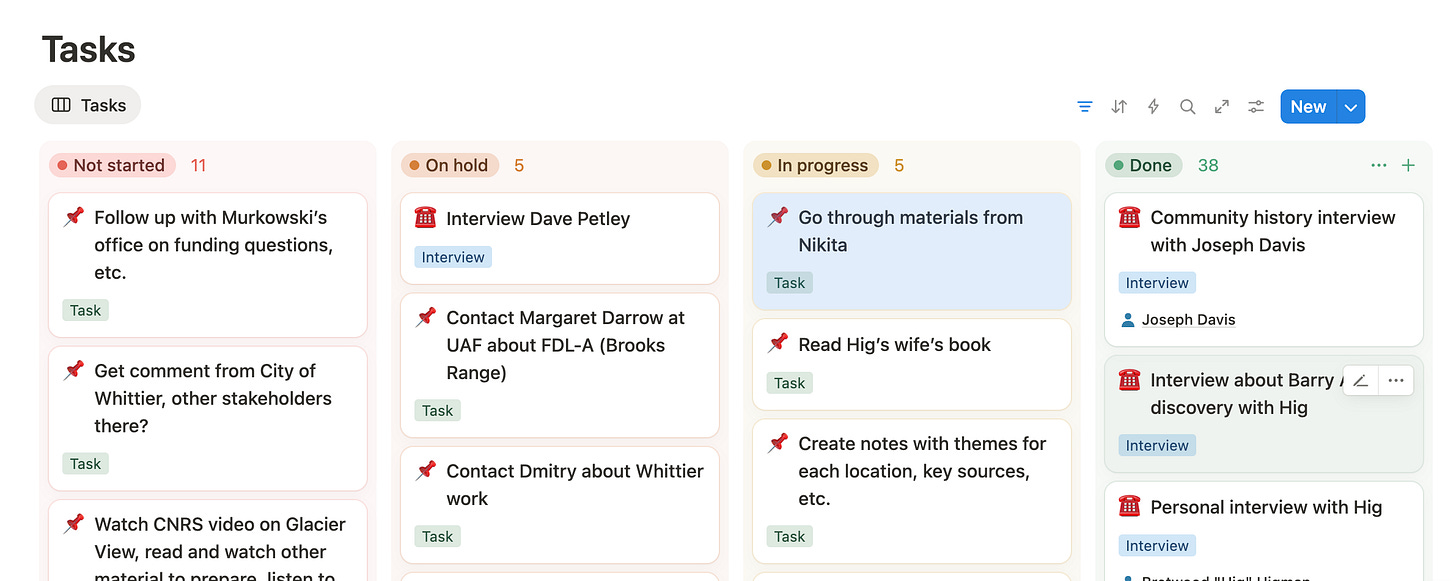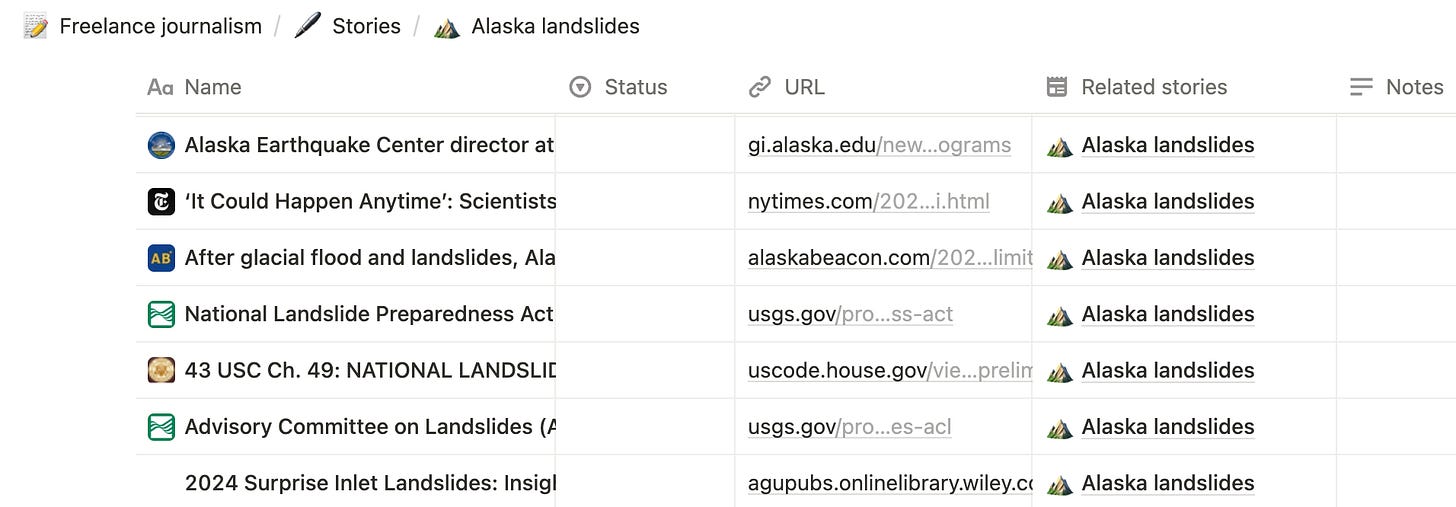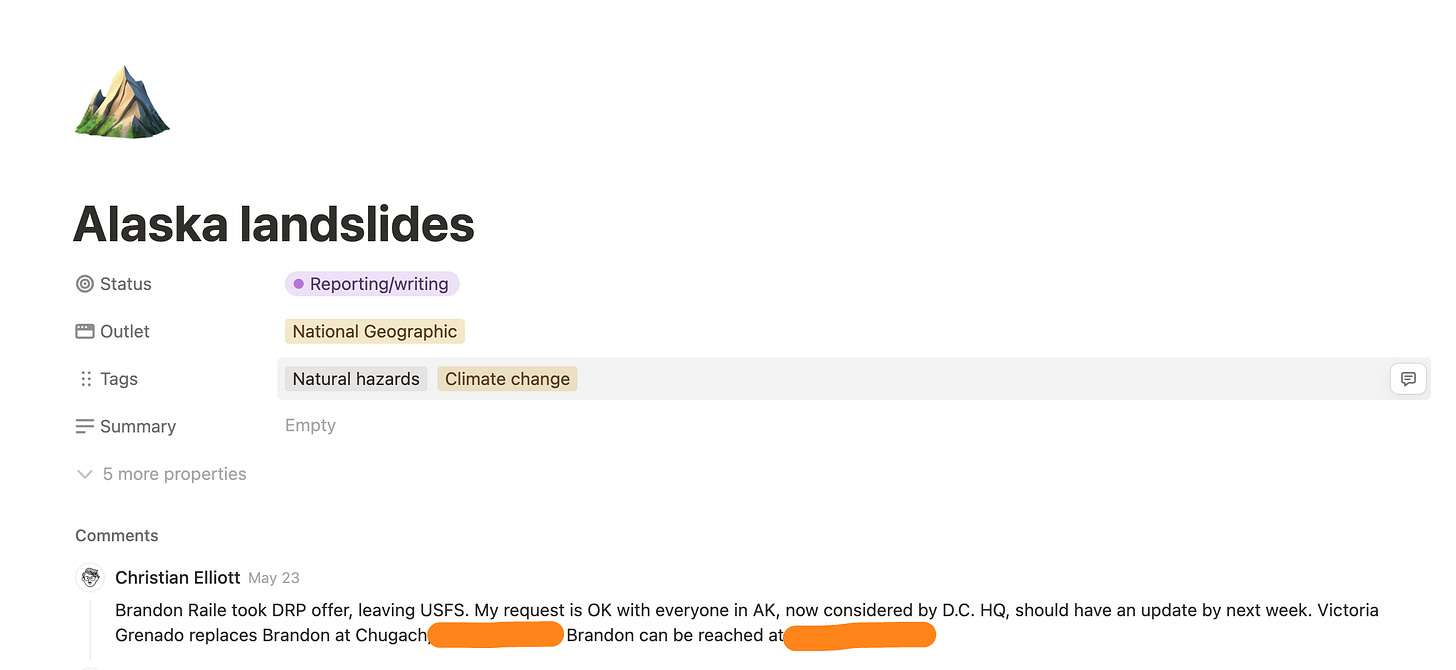A new Notion
How I keep my reporting organized, redux
Back in May, I shared how I keep my freelance reporting organized using Trello, free(ish) project management software that uses a kanban board system. I was pretty happy with it, but now I’ve completely changed how I keep track of freelance stories. And it’s because of Pocket.
I’ve used Pocket religiously for years to save stories I want to come back to later—I had literally thousands of longform features saved there that I’d go back to and read in the app (or, in some cases—to be completely transparent—never go back to). Anyway, Mozilla shut down Pocket this spring as part of a campaign among all tech companies, as far as I can tell, to enshittify the internet as thoroughly as possible.
So I set off in search of a Pocket replacement. And I quickly found Notion, another project management/personal/work/life organization software. I wasn’t really interested in becoming a Notion fanboy, but it had a feature I liked—the ability to send links, via a browser extension or the share button on mobile, to a “Read later” list.

For a while, this was my only Notion use case. But then I started to play around with it more and realized how powerful it is. I was running into some frustrations with Trello at the same time. The main text field for a card has a pretty limited character length, so I was running out of room with bigger projects/longer stories. The only other field for information is the comments, which I was using for updates of all kinds—due dates, links I wanted to come back to, interviews I wanted to schedule, etc. Notion is a lot more open ended. I spent a few days playing around with it and found a system I liked. Here it is:
At first it looks pretty similar to what I was using to track my projects in Trello—a kanban board with individual cards for each story sorted into columns for initial ideas, stories I’m actively pitching, stories I’m in the reporting/writing process for, stories that I’m in the editing process for, and published/paid/finished projects. But under the hood, there’s a lot more going on.
Notion’s superpower is it’s database-based. It’s spreadsheets all the way down. So on that initial kanban board, there are all these filters and tags you can use to sort stories—by outlet, by date, by topic, etc. The databases that feed the tracker are on the left sidebar—Tasks and notes, Sources and Research. Everything from every story is in those spreadsheets, but each card only displays the information relevant to that story within it. So for example, this feature I’m working on for National Geographic, here’s the Task tracker:
So for any story, I can create a new task and move it around in these columns based on my progress on it. I can also add a due date to a given task and it appears in the Notion calendar on that date. And this is just a data visualization, basically. So you can choose to view this in other ways—as a timeline, a list, a chart, etc. And changing the view doesn’t change the data. It’s still not a perfect system—I’d prefer to just be able to check a checkbox and make something go away instead of changing its status to “Done,” because that column can fill up fast. But it works!
Then, there’s a notes database on the story page, within the card. Again, these could be displayed on a board, in a list, etc. This is the “Gallery” view. I use Word for most of my notes, outlining, etc., but having separate note entries here has been useful to keep track of things more informally. And these notes can contain documents, images, etc.
Then there’s the research database. It’s a version of the “Read later” list. Before, I was copying links into comments on my Trello cards and I’d have to scroll forever to find what I wanted. Now I have a searchable list of all the relevant studies/stories/etc in a spreadsheet.
And finally, the part I’m probably most excited about, the source list:
I’ve cut off most of the data here for privacy, but each entry has room for contact information, tags, relevant links (to interview transcripts, personal webpages), notes, etc. I’ve been meaning to keep an overall source list/rolodex in an organized way forever. Now I finally have one that I can continuously keep updated. If I want to find a scientist I interviewed for a story, I don’t have to go into the Trello card and scroll until I find their name among the chaos—I can just open up a single database and find them.
Oh, and every page in Notion supports comments. So I’ve been using that field for quick updates I want to keep top-of-mind, like where I’m at with pitching a piece.
I’m still feeling out exactly how I want to use Notion, but I’m pretty OK with leaving Trello behind at this point. This system has solved a lot of organizational problems I’ve been having—keeping track of tasks for individual stories, keeping an organized source rolodex, juggling calendars. If you’ve been looking for a piece of software to stay on top of freelance work, my new recommendation is Notion. And if you’re procrastinating on a project, completely changing your organizational system is a great way to do that (speaking for a friend?). Stay tuned for me to change my mind again in a few months…
Oh I almost forgot, here’s a link to the template I adapted for this story tracker. And there are lots of similar Notion templates out there—you can probably find one that works for you if you don’t like this one.
Reading list
What I’ve been reading and listening to recently (and you might be interested in too). As usual, a mix of meta stuff about science journalism and some just plain good long reads and features. You might recognize some of these from my trusty “Read later” list…
Chicago has the most lead pipes in the nation. We mapped them all. (Keerti Gopal, Juanpablo Ramirez-Franco, Peter Aldhous, Clayton Aldern, & Amy Qin, Grist)
This is a really impressive investigation by the team at Grist (and Inside Climate News and WBEZ) into Chicago’s lead pipe problem. The maps and interactives are amazing, and I also really love that the team published a separate story explaining their work—what a great way to build trust among readers.
Inside NASA’s Wild Space Mission to Defend Earth Against a Planet-Killing Asteroid (Hannah Richter, Popular Mechanics)
My friend and former fellow NASA Goddard intern Hannah wrote this month’s print cover story for Popular Mechanics! It’s a cool deep dive into NASA’s DART asteroid redirection mission. I’d started as an intern just a month before DART collided with Dimorphos. It was really cool to relive that day through this piece.
The Lessons of a Glacier’s Collapse (Daniel A. Gross, The New Yorker)
In May, a Swiss glacier collapsed and buried the village of Blatten. I’d followed the story closely and spoke with scientists right afterwards, because I’d been working on a story about similar giant landslides for months already. Interesting to read The New Yorker’s take!
How WIRED Got Rolled by an AI Freelancer (WIRED)
I have never gotten a pitch accepted by WIRED, but apparently it’s because I haven’t been using AI to fabricate story ideas. It’s nice to see this transparency about what happened, but also crazy that an AI pitch made it all the way to publication…
The Future Of Podcasting Is Here, And It Sucks (Alex Sujong Laughlin, Defector)
As a podcast producer, yeah. It sucks right now. The age of Serial is over, the age of Theo Vonn and Travis Kelce has begun." If you want to understand why, this is a great read by Normal Gossip’s producer. But basically, making a good audio story, like any good piece of journalism, takes an incredible amount of time and money. And it’s hard to make that money back through advertising. Throwing a celebrity into a studio to talk for two hours, barely editing anything and publishing the conversation is a much easier, safer bet. And that’s ruining this industry. “Pivot to video,” “personality-driven,” “chat show…” all words that make me cringe.
You Can’t Hook Readers If You Don’t Trust Their Intelligence (Carmine Starnino, The Walrus)
The Walrus is a Canadian non-profit magazine that publishes a lot of great journalism and commentary. This piece really resonated with me. I came to journalism from anthropology, which doesn’t have the same limits in writing on structure and format. It’s freeing to think of writing longform stories that don’t need a nut graf that gives everything away at the top and lets readers know what they’re in for. If you hook them, they should be willing to stick along and figure things out along the way, to make up their own minds about what you’re trying to tell them!








